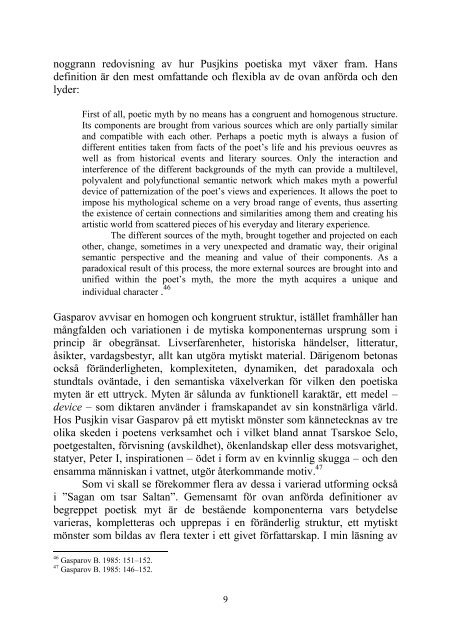Create successful ePaper yourself
Turn your PDF publications into a flip-book with our unique Google optimized e-Paper software.
noggrann redovisning av hur Pusjkins poetiska myt växer fram. Hans<br />
definition är den mest omfattande och flexibla av de ovan anförda och den<br />
lyder:<br />
First of all, poetic myth by no means has a congruent and homogenous structure.<br />
Its components are brought from various sources which are only partially similar<br />
and compatible with each other. Perhaps a poetic myth is always a fusion of<br />
different entities taken from facts of the poet’s life and his previous oeuvres as<br />
well as from historical events and literary sources. Only the interaction and<br />
interference of the different backgrounds of the myth can provide a multilevel,<br />
polyvalent and polyfunctional semantic network which makes myth a powerful<br />
device of patternization of the poet’s views and experiences. It allows the poet to<br />
impose his mythological scheme on a very broad range of events, thus asserting<br />
the existence of certain connections and similarities among them and creating his<br />
artistic world from scattered pieces of his everyday and literary experience.<br />
The different sources of the myth, brought together and projected on each<br />
other, change, sometimes in a very unexpected and dramatic way, their original<br />
semantic perspective and the meaning and value of their components. As a<br />
paradoxical result of this process, the more external sources are brought into and<br />
unified within the poet’s myth, the more the myth acquires a unique and<br />
individual character . 46<br />
Gasparov avvisar en homogen och kongruent struktur, istället framhåller han<br />
mångfalden och variationen i de mytiska komponenternas ursprung som i<br />
princip är obegränsat. Livserfarenheter, historiska händelser, litteratur,<br />
åsikter, vardagsbestyr, allt kan utgöra mytiskt material. Därigenom betonas<br />
också föränderligheten, komplexiteten, dynamiken, det paradoxala och<br />
stundtals oväntade, i den semantiska växelverkan för vilken den poetiska<br />
myten är ett uttryck. Myten är sålunda av funktionell karaktär, ett medel –<br />
device – som diktaren använder i framskapandet av sin konstnärliga värld.<br />
Hos Pusjkin visar Gasparov på ett mytiskt mönster som kännetecknas av tre<br />
olika skeden i poetens verksamhet och i vilket bland annat Tsarskoe Selo,<br />
poetgestalten, förvisning (avskildhet), ökenlandskap eller dess motsvarighet,<br />
statyer, Peter I, inspirationen – ödet i form av en kvinnlig skugga – och den<br />
ensamma människan i vattnet, utgör återkommande motiv. 47<br />
Som vi skall se förekommer flera av dessa i varierad utforming också<br />
i ”Sagan om tsar Saltan”. Gemensamt för ovan anförda definitioner av<br />
begreppet poetisk myt är de bestående komponenterna vars betydelse<br />
varieras, kompletteras och upprepas i en föränderlig struktur, ett mytiskt<br />
mönster som bildas av flera texter i ett givet författarskap. I min läsning av<br />
46 Gasparov B. 1985: 151–152.<br />
47 Gasparov B. 1985: 146–152.<br />
9

















